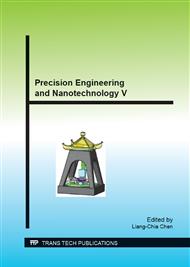[1]
S. Agarwal, P. Venkateswara Rao, Experimental investigation of surface/subsurface damage formation and material removal mechanisms in SiC grinding, Int. J. Mach. Tool Manu. 48(2008)698-710.
DOI: 10.1016/j.ijmachtools.2007.10.013
Google Scholar
[2]
X.H. Liang, B. Lin, X.S. Han, S.G. Chen, Fractal analysis of engineering ceramics ground surface, Appl. Surf. Sci. 258 (2012) 6406-6415.
DOI: 10.1016/j.apsusc.2012.03.050
Google Scholar
[3]
R.S. Sayles, T.R. Thomas, Surface topography as a nonstationary random process, Nature. 271(1978) 431-434.
DOI: 10.1038/271431a0
Google Scholar
[4]
X. Chen, J. Raja, S. Simanapalli, Multi-scale analysis of engineering surfaces, Int. J. Mach. Tool Manu. 35 (1995)231-238.
Google Scholar
[5]
B. Josso, D.R. Burton, M.J. Lalor, Wavelet strategy for surface roughness analysis and characterization, Comput. Method Appl. M. 191 (2001)829-842.
DOI: 10.1016/s0045-7825(01)00292-4
Google Scholar
[6]
S.M. Poljacek, D. Risovic, K. Furic, M. Gojo, Comparison of fractal and profilometric methods for surface topography characterization, Appl. Surf. Sci. 254 (2008)3449-3458.
DOI: 10.1016/j.apsusc.2007.11.040
Google Scholar
[7]
A. Majumdar, C.L. Tien, Fractal characterization and simulation of rough surfaces, Wear 136 (1990)313-327.
DOI: 10.1016/0043-1648(90)90154-3
Google Scholar
[8]
W. Grzesik, S. Brol, Wavelet and fractal approach to surface roughness characterization after finish turning of different workpiece materials, J Mater. Process Thch. 209 (2009)2522-2531.
DOI: 10.1016/j.jmatprotec.2008.06.009
Google Scholar
[9]
S. Tse, Y. Goa , S. Lu, A Wavelet–Fractal-Based Approach for Composite Characterisation of Engineering Surfaces, Int. J. Adv. Manuf. Tech. 20 (2002)925-930.
DOI: 10.1007/s001700200216
Google Scholar
[10]
D.M. Tsai, B. Hsiao, Automatic surface inspection using wavelet reconstruction, Pattern Recogn. 34 (2001)1285-1305.
DOI: 10.1016/s0031-3203(00)00071-6
Google Scholar
[11]
I. Daubechies, The wavelet transform, time-frequency localization and signal analysis , IEEE T. Inform. Theory. 36 (1990)961-1005.
DOI: 10.1109/18.57199
Google Scholar
[12]
S.G. Mallat, A theory for multiresolution signal decomposition: The wavelet representation, IEEE T. Pattern Anal. 11 (1989)674-693.
DOI: 10.1109/34.192463
Google Scholar
[13]
D.A. Lucca, E. Brinksmeier, G. Goch, Progress in Assessing Surface and Subsurface Integrity, CIRP Ann-manuf. Techn. 47 (1998)669-693.
DOI: 10.1016/s0007-8506(07)63248-x
Google Scholar


